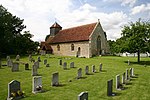Baythorne End
Braintree DistrictEssex geography stubsHamlets in EssexUse British English from February 2018
Baythorne End is a hamlet in the English county of Essex, England. It is located directly on the border with Suffolk. The hamlet is within the civil parish of Birdbrook and forms a part of the Braintree parliamentary seat. Immediate neighbouring villages include: Ridgewell, Sturmer, Stoke-by-Clare and Wixoe. Notable buildings include Baythorne Mill, Baythorne Hall, which dates from 1341 and the mansion and estate at Baythorne Park. The estate was purchased by George Pyke in 1640, where he built the Baythorne Park mansion some 28 years later. The mansion was somewhat larger than Baythorne Hall. Baythorne Park continued to be owned by the Pyke family for well over 200 years.
Excerpt from the Wikipedia article Baythorne End (License: CC BY-SA 3.0, Authors).Baythorne End
A1017,
Geographical coordinates (GPS) Address Nearby Places Show on map
Geographical coordinates (GPS)
| Latitude | Longitude |
|---|---|
| N 52.05681 ° | E 0.51404 ° |
Address
Old Post Office
A1017
CO9 4AE , Birdbrook
England, United Kingdom
Open on Google Maps







